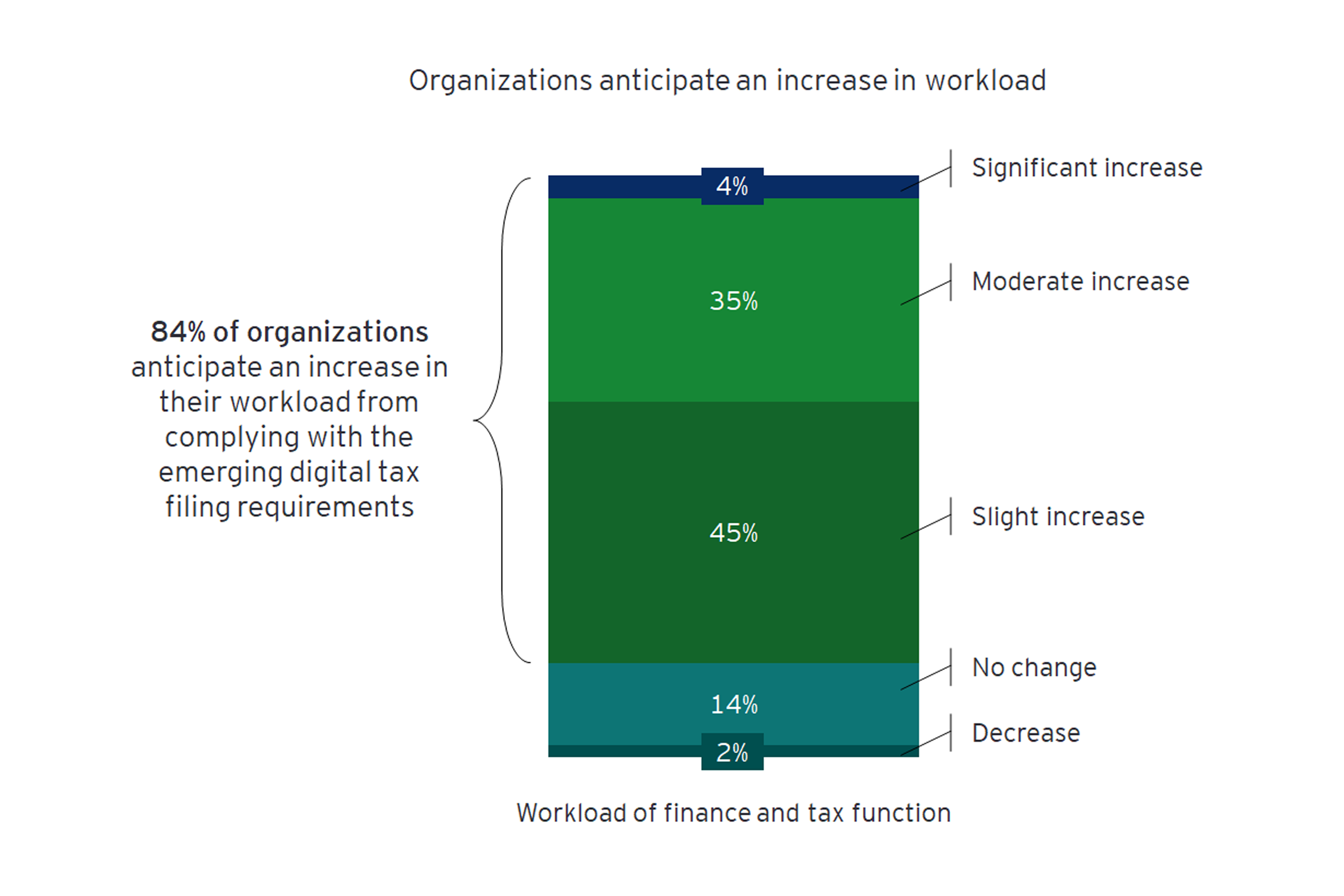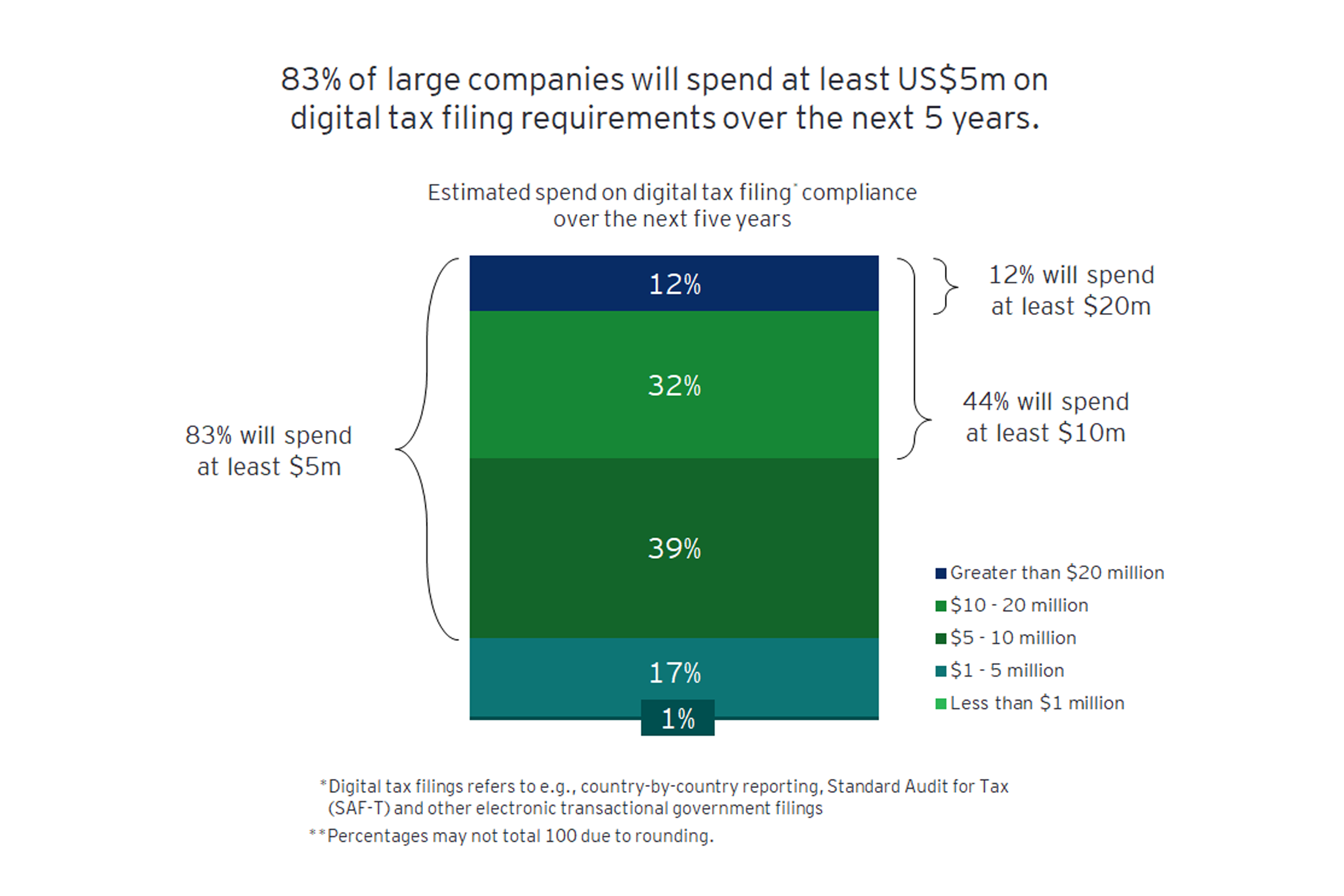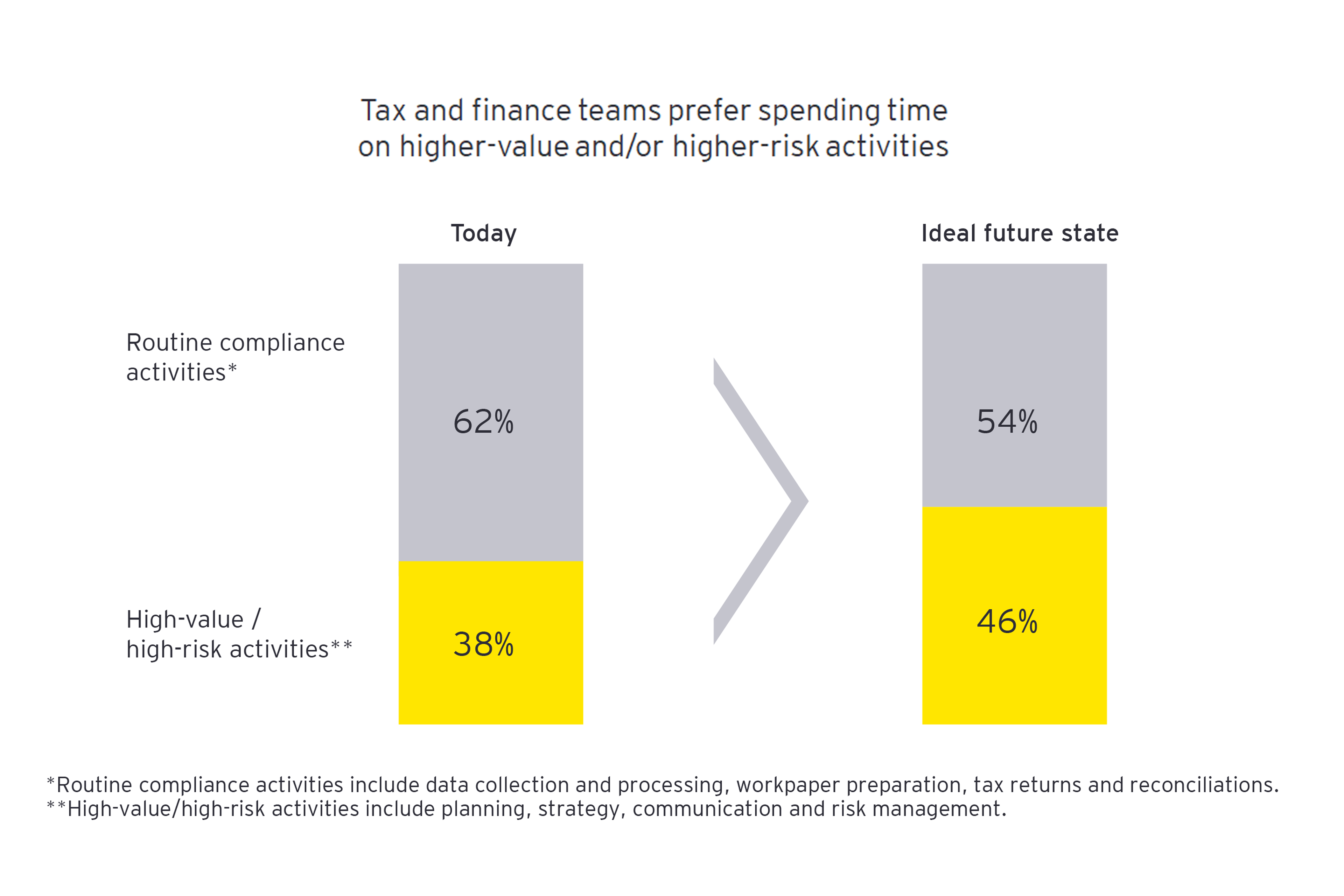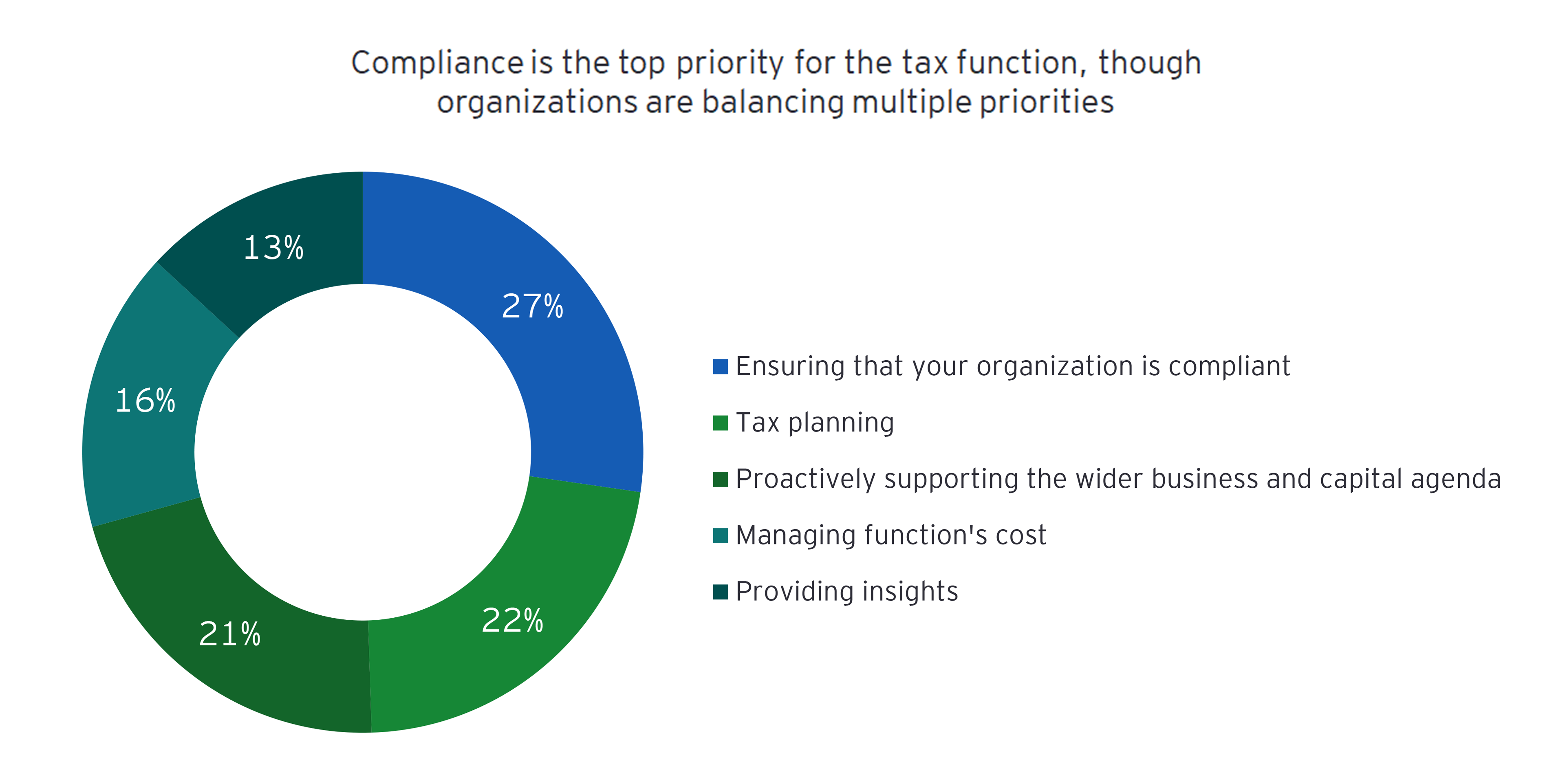
Chapter 1
The evolving tax and finance executive
As the necessary skills change, it makes it more difficult to deploy talent effectively.
People are the most important asset in any organization, and having the right people is central to solving all the challenges facing tax and finance functions today.
Traditionally, tax departments prized technical knowledge. The best tax staff knew and understood the tax codes and regulations wherever they operated. And that approach worked well in an era where tax laws were relatively stable, companies operated largely within a handful of countries, and tax returns were prepared largely on paper, providing a historical reconciliation of income and expenses for the tax authority.
Eighty-three percent of respondents said the mix of core competencies of their tax and finance personnel will shift from technical competencies to data, process and technology skills over the next three years.
Core competencies
83%of respondents said their tax and finance personnel will shift from technical focus to data, process and technology skills over the next three years.
“Today’s tax professionals still need to have world-class tax technical knowledge,” Barton says. “They also need a deep understanding of data science and to be capable of meeting new digital tax filing requirements. They should be proficient in tools such as artificial intelligence, automation, machine learning, data governance and analytics.”
Tax professionals also increasingly need to be proactive and understand the business implications of tax data and its disclosure to tax authorities and be able to communicate those effects to the C-suite. And they need to be well-positioned to interpret and act on fast-moving legislation and relief including government-enacted stimulus intended to mitigate the economic impact of the COVID-19 pandemic.
Respondents identified three challenges to creating an efficient workforce:
1. A widening of the skills gap that already exists
Thirty-nine percent of all survey respondents said they have trouble attracting and retaining people with the necessary skills to be effective in the modern tax and finance function. And 45% reported they struggle to provide new responsibilities and career advancement opportunities for their tax and finance personnel.
2. Too much time on routine compliance work
Many respondents also indicated that their people spend too much time on routine compliance work (explored more deeply in Chapter 5). The combination of too much task repetition plus barriers to skills development increases the danger that organizations could lose the talent they already have if those workers feel like career progression is impeded.
3. Skilling up for the future
Getting the talent piece of the modern tax operating model right means providing current employees with skills for the future. Learning and skills development programs should evolve with talent demands. In some cases, it may make sense to work with a service provider that already has robust continuing education programs in place to equip their tax professionals with the latest knowledge about technological tools and policy changes.

Chapter 2
Legislative and regulatory change
The unrelenting pace of new laws and rules burdens the tax and finance function.
It is no understatement to say the pace of tax legislative and regulatory change in the last decade has been staggering, and that pace is unlikely to slow. EY Worldwide Corporate Tax Guide is one barometer of the amount of change that has occurred in just a generation. The first edition in 1991 covered 106 jurisdictions and totaled 381 pages. By 2010, it had grown to 915 pages. In 2019, it took 1,352 pages to explain the corporate tax laws for the same locations featured in the 1991 book.
In the first 10 days after the World Health Organization declared COVID-19 a pandemic, stimulus measures were enacted in more than 55 jurisdictions. While the details are still settling, tax figures to a be key lever; 56% of all stimulus enacted by governments in response to the 2008 Global Financial Crisis flowed through the tax systems, according to the Organisation for Economic Cooperation and Development.
Digital across the globe
This year alone, a significant number of jurisdictions around the world are reforming their tax regimes, with many of them doing so comprehensively. Meanwhile, tax administration continues to go digital — countries far apart geographically and culturally, from Brazil to the United Kingdom, are completely digitalizing their end-to-end compliance processes. From country-by-country reports to common reporting standards to the Standard Audit File for Tax (SAF-T), the workload is building.
“I’ve been practicing tax for more than 30 years, and I’ve never experienced this sort of deluge in changing laws and regulations,” says Dave Helmer, EY Global Tax and Finance Operate Leader. “It’s not just the volume of legislation and new rules, it’s how tax concepts are being applied to the digital economy and other innovations in the modern economy. And just like any frontier, it will take a while until order and certainty take hold.”
I’ve never experienced this sort of deluge in changing laws and regulations. And just like any frontier, it will take a while until order and certainty take hold.
Indeed, the survey finds that 84% of organizations anticipate an increase in their workload from complying with emerging digital tax filing requirements, and 51% expect that those requirements will lead to an increase in their organization’s tax risk profile.

Greater size, greater cost
Large companies, with revenues of US$20 billion or more, anticipate the largest expenditures. The survey shows that 83% of them will spend at least US$5 million to comply with these new requirements over the next five years, while 44% will spend atleast US$10 million (compared with 17% across all businesses). Twelve percent of the largest companies will spend a minimum of US$20 million on these tasks.

This is a significant figure and indicates that businesses have a substantial amount of work to undertake to keep pace with the emerging requirements. While the cost of meeting these requirements may be viewed as a one-off, organizations need to make the necessary investment within an overall funding envelope that is being compressed (as highlighted in Chapter 4).
“It’s a paradox,” Helmer says. “Not only do they need to spend a lot to comply with the new laws and regulation, they also need to prepare for a reduction in costs over the longer term. Putting in place the right target operating model now will go a long way toward facilitating compliance for years to come.”
Monitoring developments
Keeping track of all of the changes — and understanding their implications — is another critical demand on modern corporate tax professionals. Companies should be confident they have the right talent and technology capabilities to monitor, evaluate and respond to major legislative change around the world and comply with digital tax filing requirements, or they should partner with someone that does.

Chapter 3
A comprehensive data and sustainable technology strategy
An ineffective data and technology implementation creates a barrier for transformation.
The digitalization of tax administration has upended the way business information is shared with authorities, and corporate tax departments need to be every bit as current with the latest technology as the governments to which they report. Moreover, tax functions must actively engage in the design and governance of the data in the underlying accounting systems.
Seeking a strategy
The 2020 EY Tax and Finance Operate survey reveals a majority of organizations (73%) have a formal tax technology strategy in place for their tax and finance function. And yet, when given a choice between identifying lack of budget, inability to hire the necessary talent, and the lack of a sustainable plan for data and technology as the biggest barrier to delivering their tax function’s purpose and vision, 65% of respondents chose a lack of sustainable data and technology plan. This is remarkable considering the well-documented budget and talent challenges facing these businesses.
This is particularly worrisome, because the pace of technological change roughly matches the pace of legislative and regulatory change, and keeping on top of developments is a big demand on talent.
“Trying to keep up with technology in addition to keeping up with legislative and regulatory change while meeting basic compliance obligations can feel overwhelming and impossible, and there can often be a lack of confidence in purchasing decisions for fear the technology may soon be out-of-date,” Helmer says. “Some businesses certainly have the resources to do it, if they choose. But increasingly we find that many prefer to work with service providers who intently focus on these matters.”
Related article
Transformation strategy
65%of organizations lack a sustainable plan for data and technology.
Technological inefficiencies
Indeed, utilization of current technology does not appear to be as operationally efficient as it could be, and only 3% of tax functions are making extensive use of disruptive technologies such as artificial intelligence (AI) and machine learning, with 15% of organizations not using them at all.
Those companies that are not investing in data and technology as part of a transformation strategy are potentially limiting their ability to achieve the tax function’s purpose and vision in the long term. Furthermore, heavy uses of spreadsheets are often the symptom of multiple data sources and systems not being set up correctly for tax. Leveraging enterprise systems can bring significant benefits for those seeking to be intelligent tax functions.
It is clear that organizations struggling to actualize their vision should take stock of what it would take to develop the enterprise-wide tax technology required and keep it current. This roadmap should build confidence in the underlying data and specify how to source the necessary elements, whether in-house, through external vendors or a hybrid approach.

Chapter 4
Cost pressures are driving decision-making
A majority of respondents plan to reduce the cost of their tax and finance function over the next two years.
While respondents to the survey anticipate a temporary increase in spending to meet the emerging digital tax filing requirements (Chapter 2), most anticipate pressure continuing over the longer term to reduce their costs.
Tightening the belt
Seventy-nine percent of respondents plan to reduce the cost of their tax and finance function over the next two years. The average cost decrease is expected to be 8.6%. This trend is more pronounced for large companies, 86% of which anticipate cutting these costs.
Organizations plan to reduce cost
79%of respondents plan to reduce the cost of their tax and finance function over the next two years.
The average target cost reduction is higher than in the previous report, when 77% of companies forecast a 6% target cost reduction over the next two years. This continuity is significant and indicates cost reductions are an ongoing and potentially increasing pressure point.
The savings threshold
Notably, respondents said it would take savings of 8% on average to consider having a third party operate select activities of their tax function. This correlation suggests that if outsourcing or co-sourcing can help them meet their 8.6% cost reduction target, it would naturally be considered as a solution. Organizational preference for in-house vs. outsourcing remains a factor, however, with certain businesses opting to make the cost reductions internally.
Trying to modernize a company’s target operating model is a perpetual struggle due to the unrelenting pace of change. Companies should decide whether to accept the ongoing challenge or hire an external vendor focused on doing just that to help them stay current with talent, technology and processes to meet all compliance obligations.

Chapter 5
The need to optimize operations
Having the right people in the right place doing the right job is an operational imperative.
Finally, the survey clearly indicates that most tax and finance executives aspire to do more. They want their people to be a value-added partner with their organizations and offer insights that improve the bottom line. Freeing them from time-consuming repetitive compliance work is a key step to making that happen.
Freeing up talent
Respondents said they feel their tax and finance personnel spend too much time (nearly two-thirds) on routine compliance activities. The anticipated increased workload from emerging tax requirements and broader financial regulation will only make this worse.
Overall, organizations would prefer their tax and finance teams to spend less time doing routine activities. This is more pronounced among larger organizations, where 66% of time is spent on routine compliance activities, compared with a desired 51%.
Related article

This need to reduce time spent on compliance is set against a backdrop in which a clear majority of respondents (83%) anticipate that, over the next three years, the core tax technical competencies of their tax and finance personnel will be augmented to include more data, process and technology skills.
For businesses with revenues of US$20 billion and over, that figure rises to 96%. This reinforces the view that larger companies are facing potentially more complex and constantly evolving challenges, particularly if they are operating in multiple jurisdictions.
Empowering these people to reach their full potential means making a choice between building the technological platform that supports these objectives or working with a vendor that already has the capabilities in place. Again, this is a highly individual decision based on each business’s needs, budget and appetite for risk.
The path forward
The way companies operate their tax and finance functions is on the cusp of a permanent, necessary change. Nearly all businesses recognize this and say they are in the process of transformation.
While it is positive that the vast majority of organizations continue to transform their operations, there are still disconnects between the strategies in theory and how change is actually being executed. Questions also remain about how sustainable those strategies are.
In light of the findings in this survey, it is evident that organizations should look broadly across their tax and finance operations both now and in the future and address them as a cohesive whole as opposed to siloed competencies. Similarly, it appears that outsourcing and co-sourcing will have a pivotal role to play.
All businesses should choose their own path forward, using the following guide:
1. Scrutinize your current target operating model. Now is the time to examine your organization’s priorities around cost controls, value creation and risk management to understand how your tax and finance function contributes to your overall business strategy. Once these priorities are clear, it is easier to identify gaps in people and technology and decide how sustainable the current model is for the future.
2. Determine what to build. Keeping tax and finance activities in-house generally requires some degree of internal transformation to optimize existing people, data processes and technology. Some organizations may decide to keep activities they consider higher value and best-in-class — for example, planning or managing tax controversy. But they need to be sure they can perform these activities with improved effectiveness and control.
3. Determine what to co-source. Some organizations may decide it’s better to co-source some activities, especially those that are more routine such as completion of tax returns, regulatory filings and data collection. It may be that co-sourcing these tasks can be performed at lower costs through centralization or use of third parties.
4. Find the right mix. Many companies will decide a hybrid approach is right for them, where they decide to continue to own some tax and finance functions they consider to be critical, while co-sourcing others. The right hybrid approach can maximize both effectiveness and efficiency while empowering their people to focus on being a value-added partner to the business by focusing on activities that improve the bottom line.
Co-sourcing to a third party can reduce overall tax costs, control unpredictable information technology expenses, and redirect internal resources to more strategic activities. It also enables organizations to leverage the vendor’s considerable and ongoing investments in the necessary talent and technology to keep pace with an ever-changing world.
Contact us
Like what you’ve seen? Get in touch to learn more.
Summary
Amid an unprecedented rate of change, most organizations are transforming their tax operations, but some are left struggling to connect sustainable strategy to execution. Companies must break out of siloed structures to address current and future challenges holistically, considering the roles both talent development and co-sourcing will play in solutions.



